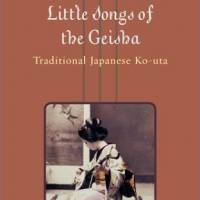The label kouta (which roughly translates as, "little song") has been applied to any number of popular Japanese music forms over the centuries. But these days, the word usually refers to a specific genre of shamisen music that evolved in 19th-century Edo (present-day Tokyo) from existing popular styles, particularly hauta (roughly, "short songs"). The first kouta is traditionally said to have been "Chiru wa Uki" ("Those that fall float"), composed in 1855 by "Joruri" puppet theater singer Kiyomoto Oyo (1840-1901), and by the early 20th century kouta was a lively and varied form — and a vital part of a geisha's repertoire of light entertainment.
Little Songs of the Geisha, Translated and edited by Liza Dalby
100 pages
Tuttle, Nonfiction.
Liza Dalby's "Little Songs of the Geisha" is a collection of 25 kouta translated with commentary.
Dalby, an anthropologist, famously spent over a year studying with the geisha of Kyoto, and began learning about nagauta ("long songs") — another shamisen genre — in her teens. Her translations are admirable renderings of some extremely ambiguous and slippery originals, with only a few odd missteps ("hyoko hyoko" is translated as onomatopoeia for a frog croaking rather than a frog jumping, for example), and her comments range from historical notes on authors and composers to musings on romance.
A pleasant introduction to a once-thriving genre that is rapidly dwindling to a very niche interest.
Read archived reviews of Japanese classics at jtimes.jp/essential.


















With your current subscription plan you can comment on stories. However, before writing your first comment, please create a display name in the Profile section of your subscriber account page.